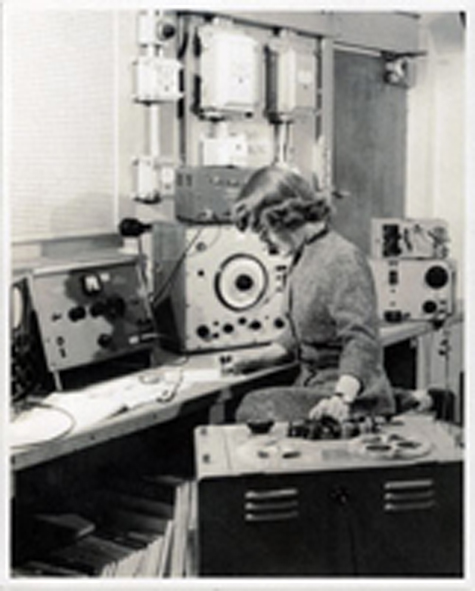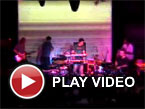Daphne Oram, "The Oram Tapes: Volume One"

Despite being one of the most visionary and iconoclastic artists to emerge from the early days of electronic music (as well as a rather fascinating and enigmatic person), Daphne Oram has only recently (and posthumously) begun to get the recognition she deserves.  Unlike the similarly wonderful and massive Oramics compilation from 2010, The Oram Tapes is comprised of largely unheard work from Daphne's mountainous tape archive that is currently being sifted through at Goldsmiths College.  That naturally means a tendency towards sketches and excepts, but it also means that it is sometimes alternately weirder, harsher, better, and more intimate than its predecessor.
Interestingly, Daphne is most famous for co-founding the BBC's Radiophonic Workshop, which used innovative technology and methods to create striking, otherworldly sound effects for shows like Dr. Who.  In fact, all of the pictures included in this release seem to be taken there, as they show Oram in a laboratory-esque environment surrounded by serious-looking men in suits.  Now here is the twist: Oram actually left both the BBC and financial stability behind in 1959 (less than a year after the Workshop was founded) due to her frustration with her employers' lack of understanding regarding her work's potential.  She set up her own studio in a hop kiln, surrounded herself with self-built and modified equipment, and quixotically managed to make a modest living making exactly the kind of strange and innovative music she wanted.  (Incidentally, my other favorite thing about Oram is an apocryphal story about how two of The Beatles visited her at her studio once and how she had absolutely no idea who they were, nor did she particularly care once she found out.)
Aside from indirectly providing sound effects for a show I despise and being super-humanly disinterested in pop culture, Daphne is also notable for being the first woman to ever design and build an electronic instrument: the Oramics machine, which converted drawings to sounds.  It is unclear how many of these recordings actually employ that technology, as she did not start using it to compose until 1968 and many of these recordings are undated.  Also, they all sound bizarre enough to have originated in any number of ways...and they did.  The most extreme example is probably her work for The Innocents, which is built from African field recordings.This is arguably the most extreme foray musically too, as the included excerpt culminates in an explosion of distorted and frightening animal howls (amusingly followed immediately by a very pleasant music box-like recording for a butter commercial).  Another commercial piece, "Anacin Components," unexpectedly turns out to be one of the album's most weirdly compelling moments, as it features Oram discussing how toothaches should sound in a very cheery and prim British way.
Aside from those rare glimpses into what Oram was actually like, my favorite pieces are the ones that still sound improbably contemporary.  "Illustrations," in particular, sounds like it could have easily emerged from the cassette underground last week (Oram unwittingly embraced tape hiss and analog synth textures way before they were cool).  Some of the other stand-out pieces are bit less musical though, as Daphne's murky and unsettling score for Hamlet sometimes sounds like a proto-Throbbing Gristle.  The Hamlet score is not a fluke either: despite her polite, square-seeming demeanor, she certainly did not shy away from catharsis, cacophony, ugliness, and industrial rumbles and shudders when it fit a piece.
There are also quite a few pieces of historical interest here, as The Oram Tapes features alternate versions and fragments of one of Daphne's major works, "Pulse Persephone."  Also, there are two pieces taken from tapes enigmatically labeled "2001," which may or may not have wound up in Kubrick's film.  That wasn't especially exciting for me (I was far more interested in finding out how toothaches sound), but it is certainly a notable inclusion.  Naturally, a double album of early electronic music (particularly one composed of mostly fragments) holds limited entertainment value for most people, as it is not an epoch that has aged particularly well.  However, as a history lesson and a portrait of a brilliant, complex, and uncompromising artist, this collection is pretty exceptional. The fact that some of the pieces still sound great is certainly nice, but being introduced to the artist eclipses the actual art (in a good way, of course).  While Oram's relative obscurity (until recently) makes it unlikely that she was a direct influence on many of today's artists, she certainly anticipated many elements of trends that hit decades later and did it on her own, in a very male-dominated milieu, and built her own goddamn instruments to do it.  If that is not inspiring, I do not know what is.
Samples:
 



